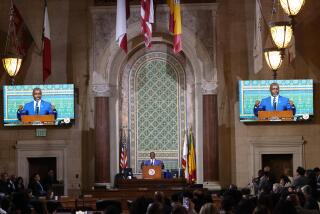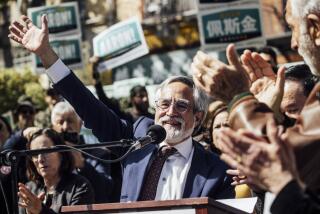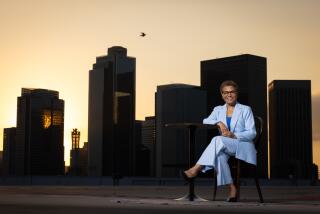Grass-Roots Government
No one is more surprised to be a City Hall insider than Larry Frank, newly appointed deputy mayor for Neighborhood and Community Services. The longtime Villaraigosa ally is a soft-spoken former union organizer who settled in Los Angeles after being recruited by the United Farm Workers nearly 30 years ago. Frank received a law degree from UCLA in 1990 and did a stint as a criminal defense lawyer before becoming staff director at the UCLA Center for Labor Research and Education downtown, a post he left for City Hall. After filling in for the mayor at a recent Westchester union hall appearance, he spoke, well, frankly, about neighborhood-level L.A.
How does it feel to be part of the establishment?
This is the first time I’ve crossed over. I’ve managed to get through my whole organizing career with hardly an enemy. I think it’s prepared me for trying to play a role. We have 1,700 elected neighborhood council leaders in our communities. That’s just a phenomenal thing. Democracy is messy, but communities are entry points to the profound richness of the city.
What’s at the top of your to-do list?
The biggest challenge facing L.A. [is improving] graduation rates in our public schools. We’re doing a “Day of Service” [drive] at six high schools on Oct. 8. We’re going to learn to engage with LAUSD and try to bring out 8,000 volunteers to some of our high schools. And challenge our neighborhood councils to get involved, adopt an elementary school maybe.
The L.A. stereotype is suburban sprawl, not a city of neighborhoods.
It’s hard for tourists to get a feel for L.A. [For example], L.A. is the most connected major city to the tragedy in Louisiana. [In the] 1920s and ‘30s, if you were black and you were in Georgia or Florida, you went to New York. If you were from Louisiana or Texas, you came to L.A. Many of the people that are black in L.A. have a connection to Louisiana. The black churches are the center right now of the real work on [Hurricane] Katrina relief.
What issues did you work on after coming to L.A. as a young organizer?
I worked first for the farm workers’ union. Then I worked on the J. P. Stevens boycott at the Amalgamated Clothing and Textiles Workers Union. Then I organized for the Communications Workers of America. Then in 1982, the nuclear weapons freeze was on the ballot, Prop. 12 I think it was. I did two city initiatives, the Jobs with Peace initiatives.
How did your relationship with the mayor start?
This was [also] in 1982. I’d heard about this Chicano who had just been elected president of the American Federation of Government Employees, Local 3230, which was an all-black local. I said, “I got to check this guy out.” A half-hour lunch turned into three hours, and we started working together. We worked together for years. He ended up being a chair of a Black-Latino Roundtable with Mark Ridley-Thomas. [Villaraigosa] saw a big picture and grasped it really quickly.
Are there lessons to be gleaned from the progressive administrations in San Francisco, Berkeley or Santa Monica?
The watchwords are competing demands: How do you move an agenda forward, and how do you hold a coalition together? You saw coalitions fall apart for people like the governor [or] the prior mayor [James Hahn]. On the other hand, if all you’re concerned about is holding your coalition together, you can’t push on issues. This is a mayor who isn’t happy unless he’s out there. Our job is to understand the complexities of every neighborhood, give him that information and get him out solving problems.
What are some neighborhoods you love?
Downtown. The Park Plaza Hotel is the most beautiful building in L.A. I’ve explored most of the buildings downtown, just wanting to learn. When I had my legal practice, I did a downtown restaurant guide. Every Christmas we’d send out the guide to let all the attorneys understand what amazing little spots there are. Also Boyle Heights. You don’t need a Third Street Promenade or an Old Town Pasadena when you have people out walking and the old sense of community there. That for me is the best of what L.A. has to offer.
You still have the 1965 Plymouth Valiant convertible you drove in your early L.A. days as a labor organizer.
I bought it from the guy who drove it off the assembly line.
More to Read
Sign up for Essential California
The most important California stories and recommendations in your inbox every morning.
You may occasionally receive promotional content from the Los Angeles Times.










